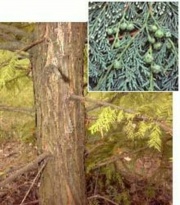Difference between revisions of "Alaska cedar"
| Line 14: | Line 14: | ||
Specific gravity = 0.5 (air dry); Odor of fresh cut surface resembles raw potatoes; Sapwood = white to yellowish; Heartwood = bright yellow when freshly cut and darkens with exposure to air; medium soft to hard; medium weight; Grain = straight; Texture = fine, even; Rays = fine; Tracheids = 30-45 microns in diameter; Density = 31 ppcf | Specific gravity = 0.5 (air dry); Odor of fresh cut surface resembles raw potatoes; Sapwood = white to yellowish; Heartwood = bright yellow when freshly cut and darkens with exposure to air; medium soft to hard; medium weight; Grain = straight; Texture = fine, even; Rays = fine; Tracheids = 30-45 microns in diameter; Density = 31 ppcf | ||
| − | |||
| − | |||
| − | |||
| − | |||
== Additional Information == | == Additional Information == | ||
| Line 27: | Line 23: | ||
<gallery> | <gallery> | ||
File:17_Alaska Cedar_100x_Tan.jpg|Alaska cedar (''Chamaecyparis nootkatensis'') | File:17_Alaska Cedar_100x_Tan.jpg|Alaska cedar (''Chamaecyparis nootkatensis'') | ||
| − | File:17_Alaska Cedar_100x_Tran.jpg|Alaska cedar | + | File:17_Alaska Cedar_100x_Tran.jpg|Alaska cedar (''Chamaecyparis nootkatensis'') |
| + | File:17_Alaska Cedar_100x_Rad.jpg|Alaska cedar (''Chamaecyparis nootkatensis'') | ||
</gallery> | </gallery> | ||
| − | |||
== Sources Checked for Data in Record == | == Sources Checked for Data in Record == | ||
| Line 36: | Line 32: | ||
* ''Dictionary of Building Preservation'', Ward Bucher, ed., John Wiley & Sons, Inc., New York City, 1996 | * ''Dictionary of Building Preservation'', Ward Bucher, ed., John Wiley & Sons, Inc., New York City, 1996 | ||
| − | |||
[[Category:Materials database]] | [[Category:Materials database]] | ||
Revision as of 13:28, 19 June 2020
Description
A large, softwood tree, Chamaecyparis nootkatensis, found in the Pacific Northwest. Alaska cedar belongs to the cypress family, but is called a cedar because of its aromatic smell. The yellow wood has an even texture and a fine, straight grain. Alaska cedar is used for boat building, veneers, lumber, cabinetry, closets, and chests. It is very durable and has the advantage of being resistant to insects and rotting. Yellow cedar fibers, carefully prepared from strips of the inner bark, were woven, often mixed with wool, into blankets and cords by the Salish, Kwakiutl, and Tlingit tribes (King and Hartley 1979).
Synonyms and Related Terms
Chamaecyparis nootkatensis; Alaskan cedar; Alaska cypress; yellow cypress; yellow cedar;
Other Properties
Specific gravity = 0.5 (air dry); Odor of fresh cut surface resembles raw potatoes; Sapwood = white to yellowish; Heartwood = bright yellow when freshly cut and darkens with exposure to air; medium soft to hard; medium weight; Grain = straight; Texture = fine, even; Rays = fine; Tracheids = 30-45 microns in diameter; Density = 31 ppcf
Additional Information
R.King, E.Hartley, "Unusual Fibers Used in Northwest Coast Ethnographic Textiles, Their Preparation & Their Structure", Technology & Conservation 1/79.
Additional Images
Sources Checked for Data in Record
- G.S.Brady, Materials Handbook, McGraw-Hill Book Co., New York, 1971 Comment: p. 258
- Dictionary of Building Preservation, Ward Bucher, ed., John Wiley & Sons, Inc., New York City, 1996




